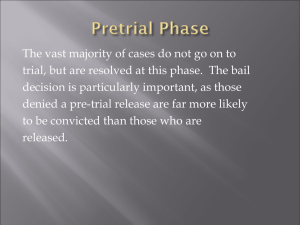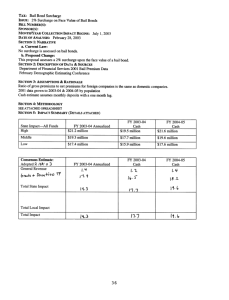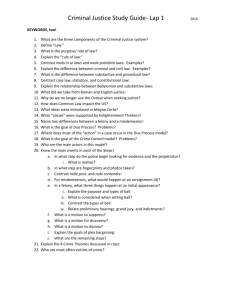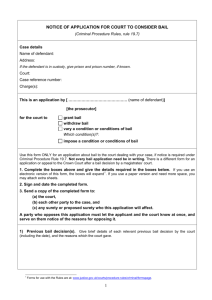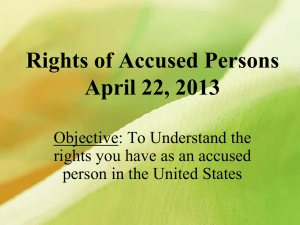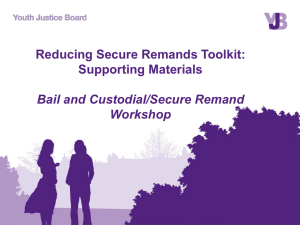Criminal Procedure
advertisement
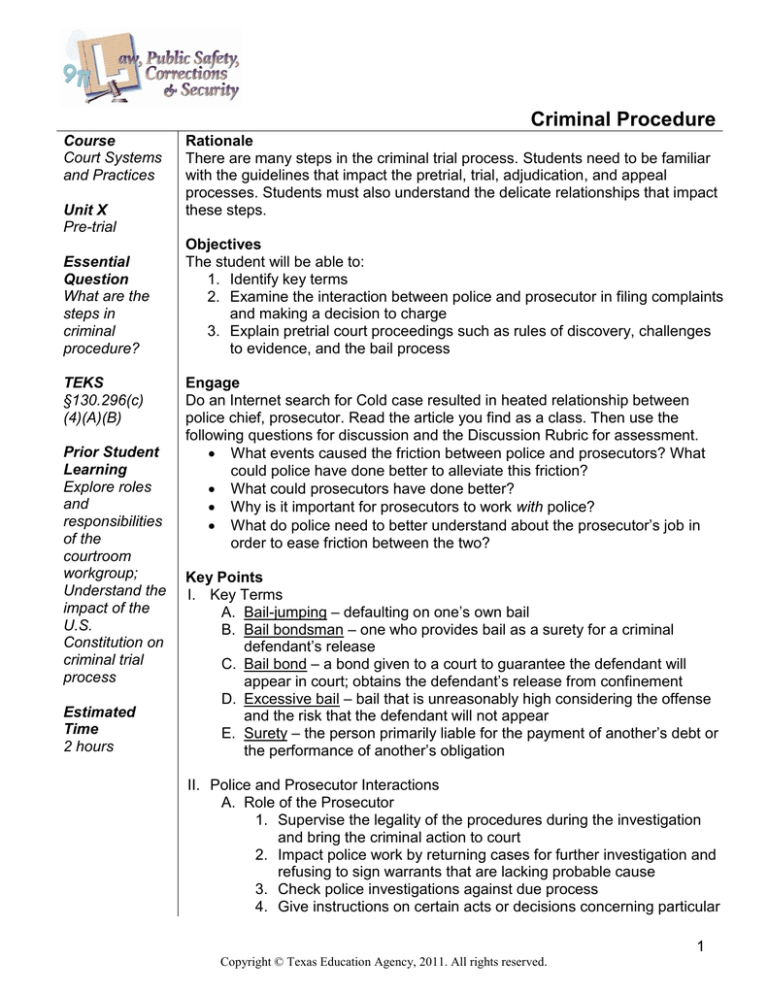
Criminal Procedure Course Court Systems and Practices Unit X Pre-trial Essential Question What are the steps in criminal procedure? TEKS §130.296(c) (4)(A)(B) Prior Student Learning Explore roles and responsibilities of the courtroom workgroup; Understand the impact of the U.S. Constitution on criminal trial process Estimated Time 2 hours Rationale There are many steps in the criminal trial process. Students need to be familiar with the guidelines that impact the pretrial, trial, adjudication, and appeal processes. Students must also understand the delicate relationships that impact these steps. Objectives The student will be able to: 1. Identify key terms 2. Examine the interaction between police and prosecutor in filing complaints and making a decision to charge 3. Explain pretrial court proceedings such as rules of discovery, challenges to evidence, and the bail process Engage Do an Internet search for Cold case resulted in heated relationship between police chief, prosecutor. Read the article you find as a class. Then use the following questions for discussion and the Discussion Rubric for assessment. What events caused the friction between police and prosecutors? What could police have done better to alleviate this friction? What could prosecutors have done better? Why is it important for prosecutors to work with police? What do police need to better understand about the prosecutor’s job in order to ease friction between the two? Key Points I. Key Terms A. Bail-jumping – defaulting on one’s own bail B. Bail bondsman – one who provides bail as a surety for a criminal defendant’s release C. Bail bond – a bond given to a court to guarantee the defendant will appear in court; obtains the defendant’s release from confinement D. Excessive bail – bail that is unreasonably high considering the offense and the risk that the defendant will not appear E. Surety – the person primarily liable for the payment of another’s debt or the performance of another’s obligation II. Police and Prosecutor Interactions A. Role of the Prosecutor 1. Supervise the legality of the procedures during the investigation and bring the criminal action to court 2. Impact police work by returning cases for further investigation and refusing to sign warrants that are lacking probable cause 3. Check police investigations against due process 4. Give instructions on certain acts or decisions concerning particular 1 Copyright © Texas Education Agency, 2011. All rights reserved. matters B. Joint Roles 1. Police and District Attorney (DA) investigators may both be responsible for the investigation 2. Prosecutors without police cooperation will have problems investigating and presenting evidence in court 3. Police and prosecutors often have conflicting views about the dispositions of cases 4. Both parties want justice for the victims 5. Both parties present evidence at the trial C. Role of the Police 1. Investigate the crime 2. Protect the victim 3. Provide evidence and testimony in court 4. Depend on prosecutors to advise them on legal issues and hold them accountable in regards to constitutional rights 5. Criticize prosecutors when they choose not to prosecute 6. Lack of shared common goals can lead to police developing practices that are not compatible with prosecutorial purposes, such as relying on evidence that is inadmissible in court III. Pre-trial Proceedings A. Rules of Discovery 1. Discovery is the formal process by which the defense and prosecution exchange information relevant to a criminal investigation a. Provides pertinent information b. Aids in adequate preparation for the trial c. Helps the criminal justice system reach reliable outcomes d. Evidence can be appropriately scrutinized and then give the accused a meaningful opportunity to challenge and test it 2. Code of Criminal procedure (CCP, Art. 39.14) B. Rules of Evidence 1. General purpose a. Restricts the content and manner of presentation b. Ensures that the trial runs smoothly c. Protects against unfair trials d. It is the role of the prosecutor and defense to challenge rule of evidence violations 2. Rules Regulating Testimony a. Purpose is to influence opinion of the judge and jury b. Testimony must be logically connected to the issue and deemed admissible c. Testimony that is logical to issues is not always admissible d. The witness must testify only on firsthand information (Personal Knowledge Rule) e. Testimony of character by the defendant or others (The Mercy Rule) 2 Copyright © Texas Education Agency, 2011. All rights reserved. f. “Bad character” evidence may not be submitted unless “good character” evidence is presented first g. Witness credibility can be challenged by attacking honesty and criminal activity h. If no good character evidence is entered, then the defendant’s past convictions cannot be entered i. Rape victims are shielded from attacks on their sexual history under the Rape Shield laws j. Hearsay rules prevent testimony that is not firsthand from being admitted k. Statements not subjected to cross-examination are not permitted l. Expert testimony may include opinions and references to previous witness’ testimony. Expert testimony may be paid m.The “Chain of Custody” rule regulates the admissibility and credibility of evidence to ensure evidence is not tampered with or somehow altered prior to the trial 3. Rules Regarding Scientific Evidence a. Includes scientific or forensic evidence b. Scientific evidence entered by both sides i. DNA ii. Fingerprints iii. Ballistics c. Polygraph results are not considered reliable and are not admissible d. Other forms of altered consciousness statements are not accepted e. The judge determines admissibility by considering i. Validity of the evidence ii. Credibility of the science behind it iii. How influential the evidence may be 4. Rules Regarding Confidential Information a. Privileged relationships prevent the disclosure of private information. Privileged relationships include i. Spouse ii. Medical doctors and patients iii. Attorneys and clients iv. Ministers and church members a. Private information cannot be released without the consent of the holder b. Confidentiality Exceptions i. A client telling his or her attorney he or she will commit a crime in the future ii. The holder of privileged information also elects to include a third party in the communication C. Bail Process 1. Order of Process a. Arrest 3 Copyright © Texas Education Agency, 2011. All rights reserved. b. Booking (jail) c. Arraignment i. The judge determines if the subject is eligible for bail and the cost ii. The judge takes into account a) Seriousness of the crime b) Flight risk c) Criminal history d) Ties to the community e) Danger to others 2. Types of Bail a. Cash Bail – the accused pays the full amount of bail in cash. The court may accept checks or credit cards b. Surety Bond (Bail Bond) i. The bail bondsman pledges to pay the full value of the bond if the accused does not appear in court. The bail bondsman charges 10–20% and collects some sort of collateral that usually involves a friend or a relative ii. If the defendant fails to appear before the court, the bail bondsman is responsible for paying the entire bail amount iii. A bounty hunter is then contracted to locate the defendant and bring him or her before the court a. Release on Citation – the suspect is issued a citation to appear before a court at a later date b. Release on Own Personal Recognizance – the suspect is responsible for showing up to court dates and does not pay bail. It is highly unlikely the person will flee and not appear for court c. Property Bonds – the defendant provides property as a bond and a lien is placed on the property. If the defendant fails to show for court the property is foreclosed on to recover the bail Activities Texas Code of Criminal Procedure. Give each student a Texas Code of Criminal Procedure (CCP, Art. 39.14) handout. Have the students read over the Rules for Discovery as outlined in this article of the CCP. Have students make a list of all the items that must be disclosed according to this rule. Then have students write a brief interpretation of the rules of discovery. Use the Writing Rubric for assessment. Assessments Criminal Procedure Exam and Key Criminal Procedure Brochure Rubric Discussion Rubric Individual Work Rubric Writing Rubric 4 Copyright © Texas Education Agency, 2011. All rights reserved. Materials Criminal Procedure computer-based presentation Texas Code of Criminal Procedure (CCP, Art. 39.14) handout Internet access Supplies to make brochures or desktop publishing software Resources Texas Code of Criminal Procedure (CCP, Art. 39.14) http://www.statutes.legis.state.tx.us/Docs/CR/htm/CR.39.htm Do an Internet search for the following: Cold case resulted in heated relationship between police chief, prosecutor Lawfirms evidence in criminal trials How bail works Relationship between the Prosecution Service and the Police Accommodations for Learning Differences For reinforcement, bring in two guest speakers, one police officer and one prosecutor (either city or county), and have them talk about their relationship in the criminal justice system. Before the speakers come, but after completing this lesson, have students write five questions for each speaker. The questions must be submitted to the instructor for review. The most worthy questions will be selected to ask the guest speakers during their presentation. Use the Individual Work Rubric for assessment. For enrichment, have students prepare a brochure explaining the bail process. The brochure should include the five types of bail, an outline of the bail process, and specific information about how bail is granted. The brochure should be tri-fold and easy to read. Use the Criminal Procedure Brochure Rubric to assess student understanding. State Education Standards Texas Essential Knowledge and Skills for Career and Technical Education §130.296. Court Systems and Practices (One to Two Credits). (4) The student examines the steps by which a criminal charge is processed through pretrial, trial, adjudication, and the appellate stages. The student is expected to: (A) examine the interaction between police and prosecutor in filing complaints and making a decision to charge; (B) explain pretrial court proceedings such as rules of discovery, challenges to evidence, and the bail process; College and Career Readiness Standards English/Language Arts Standards II. Reading B Understand new vocabulary and concepts and use them accurately in reading, writing and speaking. 5 Copyright © Texas Education Agency, 2011. All rights reserved. 1. Identify new words and concepts acquired through study of their relationships to other words and concepts. 6 Copyright © Texas Education Agency, 2011. All rights reserved. Texas Code of Criminal Procedure (CCP Article 39.14) Art. 39.14. DISCOVERY. (a) Upon motion of the defendant showing good cause therefore and upon notice to the other parties, the court in which an action is pending shall order the State before or during trial of a criminal action therein pending or on trial to produce and permit the inspection and copying or photographing by or on behalf of the defendant of any designated documents, papers, written statement of the defendant, (except written statements of witnesses and except the work product of counsel in the case and their investigators and their notes or report), books, accounts, letters, photographs, objects or tangible things not privileged, which constitute or contain evidence material to any matter involved in the action and which are in the possession, custody or control of the State or any of its agencies. The order shall specify the time, place and manner of making the inspection and taking the copies and photographs of any of the aforementioned documents or tangible evidence; provided, however, that the rights herein granted shall not extend to written communications between the State or any of its agents or representatives or employees. Nothing in this Act shall authorize the removal of such evidence from the possession of the State, and any inspection shall be in the presence of a representative of the State. (b) On motion of a party and on notice to the other parties, the court in which an action is pending may order one or more of the other parties to disclose to the party making the motion the name and address of each person the other party may use at trial to present evidence under Rules 702, 703, and 705, Texas Rules of Evidence. The court shall specify in the order the time and manner in which the other party must make the disclosure to the moving party, but in specifying the time in which the other party shall make disclosure the court shall require the other party to make the disclosure not later than the 20th day before the date the trial begins. 7 Copyright © Texas Education Agency, 2011. All rights reserved. Name________________________________ Date__________________________ Criminal Procedure Exam 1) Under the Rules of Regulating Testimony, "bad character" evidence may not be entered unless: a) Witness credibility can be challenged b) The "Mercy Rule" is enacted c) Good character evidence is entered first d) Testimony is logical to issue 2) Witnesses must testify only to firsthand information. This guideline comes from which rule? a) Personal Knowledge Rule b) The Mercy Rule c) Rape Shield Law d) Good Character Rule 3) Which rule regulates admissibility and credibility of evidence to ensure evidence was not tampered with or somehow altered prior to trial? a) Personal Knowledge Rule b) The Mercy Rule c) Chain of Custody d) Good Character Rule 4) Expert testimony may include which of the following? a) Character testimony b) Opinion about and references to previous witness testimony c) Illogical testimony that is inadmissible d) Bad character evidence along with the criminal history of the defendant 5) Rape Shield laws protect against which of the following? a) Testimony that is not first-hand but is being admitted b) Bad character evidence that is being admitted prior to good character evidence c) Victims being attacked based on their ethnicity d) Rape victims being attacked about their sexual history 8 Copyright © Texas Education Agency, 2011. All rights reserved. 6) Which of the following is not a form of scientific evidence? a) Polygraph b) DNA c) Ballistics d) Fingerprints 7) Which is not a factor that the judge uses in determining admissibility of scientific evidence? a) Validity of evidence b) If evidence is scientific or forensic c) Credibility of the science behind it d) How influential the evidence may be 8) Under the Rule of Confidentiality, which of the following is not considered a privileged relationship? a) Spouse b) Attorney and a client that says he will commit another crime c) Medical doctors and patients d) Ministers and members 9) Defaulting on one’s bail is called what? a) Bail-jumping b) Bail bondsman c) Surety d) Bail bond 10) One who provides bail as a surety for a criminal defendant’s release is called? a) Bail-jumping b) Bail bondsman c) Bail bond d) Property bond 9 Copyright © Texas Education Agency, 2011. All rights reserved. 11) A bond that is given to a court to guarantee that the defendant will appear in court and obtains the defendant’s release from confinement is called what? a) Cash bail b) Surety bond c) Recognizance bail d) Bail bond 12) The person primarily liable for the payment of another’s debt or for the performance of another’s obligation is called? a) Surety b) Bail bond c) Bail bondsman d) Cash bail 13) Which is not a type of bail? a) Cash bail b) Property bond c) Surety d) Own personal recognizance 14) When the accused pays the full amount of bail with cash, check or credit card it is called what? a) Surety bond b) Cash bail c) Property bond d) Release on citation 15) The bail bondsman pledges to pay the full value of the bond if the accused does not appear in court. A bounty hunter is contracted if the defendant does not appear for court. This describes which of the following? a) Cash bail b) Bail bond c) Surety bond d) Property bond 10 Copyright © Texas Education Agency, 2011. All rights reserved. 16) Suspects who are issued citations must do what? a) Pay a bail bond b) Be booked into jail c) Appear before a judge immediately d) Appear before the court at a later time 17) The suspect is responsible for showing up for the court date and does not have to pay bail is called what? a) Release on citation b) Surety Bond c) Own Personal recognizance d) Property Bond 18) The defendant provides the property as a bond and a lien is placed on the property. If the defendant fails to appear for court, the property will be foreclosed. This describes which of the following? a) Own personal recognizance b) Surety bond c) Cash bail d) Property bond 19) The formal process by which the defense and the prosecution exchange information relevant to a criminal investigation is called what? a) Challenge of evidence b) Discovery c) Rule Regulating testimony d) Rule regarding scientific evidence 20) The Rule of Discovery does all of the following except: a) Provides pertinent information b) Appropriately scrutinizes evidence c) Resists adequate preparation for trial d) Helps the criminal justice system reach reliable outcomes 11 Copyright © Texas Education Agency, 2011. All rights reserved. 21) Criminal cases can be investigated by whom? a) Police b) Prosecutor's investigator c) Prosecutor’s investigator and/or the police d) None of the above 22) Which of the following is a main job of the prosecutor? a) Dismiss cases b) Supervise legality of procedures c) Arrest suspects d) Determine the amount of bail 23) Police depend on prosecutors to advise them about which of the following? a) Legal issues b) Hold them accountable on constitutional issues c) Both a and b d) None of the above 24) Which of the following is not a stressor in the relationship between police and prosecutors? a) Prosecutors decide not to prosecute a case b) Both prosecutors and police work together to bring criminal action to court c) Relying on evidence that is inadmissible d) Cases are returned for lack of probable cause 25) Which of the following is not true regarding evidence? a) Restricts the content and the manner of the presentation b) It is the role of the police to challenge rule of evidence violations c) Ensures that the trial runs smoothly d) Protects against an unfair trial 12 Copyright © Texas Education Agency, 2011. All rights reserved. Criminal Procedure Exam Key 1. C 2. A 3. C 4. B 5. D 6. A 7. B 8. B 9. A 10. B 11. D 12. A 13. C 14. B 15. C 16. D 17. C 18. D 19. B 20. C 21. C 22. B 23. C 24. B 25. B 13 Copyright © Texas Education Agency, 2011. All rights reserved. Name_______________________________________ Date_______________________________ Criminal Procedure Brochure Rubric Objectives Attractiveness and Organization Content Accuracy Knowledge Gained 4 pts. Excellent The brochure has exceptionally attractive formatting and well-organized information. Includes: -The five types of bail -An outline of the bail process -Specific information about how bail is granted Students can accurately answer all questions related to the facts in the project and the processes used to create the project. 3 pts. Good The brochure has attractive formatting and well-organized information. 2 pts. Needs Some Improvement The brochure has well-organized information. Includes all but one: -The five types of bail -An outline of the bail process -Specific information about how bail is granted Students can accurately answer most questions related to facts in the project and processes used to create the project Includes all but two: -The five types of bail -An outline of the bail process -Specific information about how bail is granted Student can accurately answer some of the questions related to facts in the project and processes used to create a project. 1 pt. Needs Much Improvement The brochure's formatting and organization are confusing to the reader. Excludes all but one: -The five types of bail -An outline of the bail process -Specific information about how bail is granted N/A Pts. Student appears to have insufficient knowledge about the facts or processes used in the project. Total Points (12 pts.) Comments: 14 Copyright © Texas Education Agency, 2011. All rights reserved. Name_______________________________________ Date_______________________________ Discussion Rubric Objectives 4 pts. Excellent 3 pts. Good 2 pts. Needs Some Improvement 1 pt. Needs Much Improvement N/A Pts. Participates in group discussion Encourages others to join the conversation Keeps the discussion progressing to achieve goals Shares thoughts actively while offering helpful recommendations to others Gives credit to others for their ideas Respects the opinions of others Involves others by asking questions or requesting input Expresses thoughts and ideas clearly and effectively Total Points (32 pts.) Comments: 15 Copyright © Texas Education Agency, 2011. All rights reserved. Name______________________________________ Date_______________________________________ Individual Work Rubric 4 pts. Excellent Objectives 3 pts. Good 2 pts. Needs Some Improvement 1 pt. Needs Much Improvement N/A Pts. Follows directions Student completed the work as directed, following the directions given, in order and to the level of quality indicated Time management Student used time wisely and remained on task 100% of the time Organization Student kept notes and materials in a neat, legible, and organized manner. Information was readily retrieved Evidence of learning Student documented information in his or her own words and can accurately answer questions related to the information retrieved *Research/Gathering information (if relevant) Student used a variety of methods and sources to gather information. Student took notes while gathering information Total Points (20 pts.) Comments: 16 Copyright © Texas Education Agency, 2011. All rights reserved. Name:____________________________________ Date:_____________________________ Writing Rubric 4 pts. Excellent Objectives 3 pts. Good 2 pts. Needs Some Improvement 1 pt. Needs Much Improvement N/A Pts. The writing has all required parts from introduction to conclusion in smooth transition. The writing is interesting, supportive, and complete. The writing demonstrates that the writer comprehends the writing process. Accurate spelling, grammar, and punctuation The content of paragraphs emphasizes appropriate points. The writer shows an understanding of sentence structure, paragraphing, and punctuation. All sources and references are clearly and accurately documented. Total Points (28 pts.) Comments: 17 Copyright © Texas Education Agency, 2011. All rights reserved.
